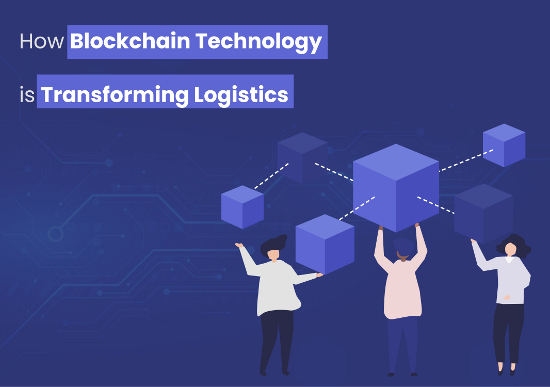Blockchain technology has been making waves in various industries, including finance, healthcare, and real estate. Another sector that is being revolutionized by this decentralized technology is logistics. Blockchain technology is transforming logistics by improving supply chain management, enhancing transparency, and ensuring greater security.
Supply chain management involves the coordination of various stakeholders, including manufacturers, suppliers, distributors, and retailers. Traditionally, the supply chain has been managed using centralized systems, which can be inefficient and prone to errors. Blockchain technology provides a decentralized alternative that is more secure and efficient.


With blockchain technology, all stakeholders in the supply chain have access to the same data, stored on a shared, immutable ledger. This means that everyone has access to the same information, reducing the need for intermediaries and enabling greater transparency. For example, if a shipment is delayed, all parties can immediately see the reason for the delay and take appropriate action.
One of the most significant benefits of blockchain technology in logistics is enhanced transparency. The technology allows all parties in the supply chain to track products from the point of origin to the point of consumption. This transparency is particularly beneficial in industries like food and pharmaceuticals, where product quality and safety are critical. By tracking the movement of goods on the blockchain, stakeholders can ensure that products are not tampered with or contaminated.
Blockchain technology also provides greater security for supply chain management. Traditional supply chain systems are vulnerable to fraud and cyber attacks, which can result in loss of inventory, revenue, and reputational damage. Blockchain technology uses cryptographic algorithms to secure the ledger, making it virtually impossible to tamper with or alter the data stored on it. This makes it easier to identify and prevent fraud and cyber attacks.
Another benefit of blockchain technology in logistics is improved efficiency. Traditional supply chain systems are often inefficient and slow, requiring manual intervention and paper-based documentation. By using blockchain technology, supply chain management can be automated, reducing the need for intermediaries and speeding up the process. This results in faster delivery times, lower costs, and greater customer satisfaction.
The use of blockchain technology in logistics is already being implemented by a number of companies. For example, Walmart is using blockchain technology to track the movement of food products from farms to stores. This enables the company to quickly identify the source of any foodborne illnesses and remove contaminated products from the shelves.
Maersk, the world’s largest container shipping company, is also using blockchain technology to enhance supply chain management. The company is using blockchain technology to track the movement of goods from the point of origin to the point of consumption, providing greater transparency and security for its customers.
Challenges in current Supply Chain Infrastructure:
The supply chain infrastructure is the backbone of the global economy, and it is constantly evolving to meet the changing demands of consumers and businesses. However, there are several challenges that the current supply chain infrastructure faces, including:
Lack of Transparency: The lack of transparency in the supply chain is a major challenge. It can be difficult to track products from the point of origin to the point of consumption, making it challenging to identify the source of any problems that may arise.
Inefficiencies: Supply chain inefficiencies result in increased costs and longer lead times. Manual processes, redundant activities, and insufficient communication among stakeholders can cause delays and errors in the supply chain.
Limited Collaboration: Collaboration among stakeholders in the supply chain is critical for success, but it can be challenging to achieve. Different stakeholders often have different priorities, which can make it difficult to find common ground and work together effectively.
Cybersecurity Risks: The supply chain infrastructure is vulnerable to cybersecurity risks, including data breaches and cyber attacks. The increasing reliance on technology in the supply chain makes it an attractive target for cybercriminals.
Environmental Impact: The supply chain has a significant environmental impact, contributing to greenhouse gas emissions, waste, and pollution. The current supply chain infrastructure often prioritizes efficiency over sustainability, which can have negative consequences for the environment.
Supply Chain Disruptions: The supply chain is vulnerable to disruptions, such as natural disasters, geopolitical conflicts, and pandemics. These disruptions can cause delays, shortages, and price increases, creating challenges for businesses and consumers.
Regulatory Compliance: The supply chain is subject to various regulatory requirements, including safety standards, labor laws, and trade regulations. Compliance with these requirements can be challenging, particularly for businesses operating across multiple jurisdictions.
How Blockchain-based Supply Chain Works?
Blockchain-based supply chain management is a decentralized approach that provides enhanced transparency, security, and efficiency in the movement of goods and services. Here is how blockchain-based supply chain works:
Recording Information on the Blockchain:
The first step in a blockchain-based supply chain is recording information on the blockchain. This includes information about the product, such as its origin, composition, and quality, as well as information about the parties involved in the supply chain, such as manufacturers, distributors, and retailers.
Creating Smart Contracts:
Smart contracts are created to automate the supply chain process. These contracts are self-executing agreements that automatically trigger actions when certain conditions are met. For example, a smart contract may be created to trigger the release of payment when a product is delivered.
Tracking the Movement of Goods:
As the product moves through the supply chain, its movement is tracked using sensors and other tracking devices. This information is recorded on the blockchain, allowing all parties to track the product’s location and status.
Verifying the Product:
At various points in the supply chain, the product is verified to ensure its authenticity, quality, and safety. This may include inspections, testing, and other verification processes. The results of these processes are recorded on the blockchain, providing a transparent record of the product’s journey.
Enabling Real-Time Visibility:
Blockchain-based supply chain management enables real-time visibility into the movement of goods. All parties in the supply chain have access to the same information, stored on a shared, immutable ledger. This eliminates the need for intermediaries and enhances transparency.
Resolving Disputes:
In the event of disputes, blockchain-based supply chain management can provide a transparent and secure way to resolve them. The blockchain provides a tamper-proof record of all transactions, making it easier to identify the source of any problems and take appropriate action.
Ensuring Payment:
Blockchain-based supply chain management can also automate the payment process, ensuring that all parties receive payment in a timely and secure manner. Smart contracts can be used to trigger the release of payment when certain conditions are met, reducing the risk of fraud and errors.
















